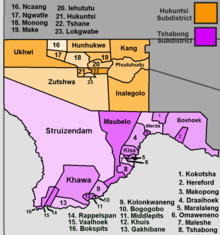Kgalagadi District
Kgalagadi | |
|---|---|
UTC+2 (Central Africa Time) | |
| HDI (2017) | 0.683[1] medium · 8th |
Kgalagadi is a district in southwest Botswana, lying along the country's border with Namibia and South Africa. The administrative center is Tsabong. The district of Kgalagadi covers a large part of the Kalahari Desert. It has a total area of 105,200 km2 and has a population of 42,000 (2001). More than one-third of the district is covered by the Kgalagadi Transfrontier Park
As of 2011, the total population of the district was 50,492 (compared to 42,049 in 2001). The growth rate of population during the decade was 1.85. Kgalagadi's population represents 2.49 per cent of the total population of Botswana. The majority of employees (in 2011 there were 10,530 people in work) were working within the transport & communication and public administration sectors. The district is administered by a district administration and district council.[citation needed]
Geography

Kgalagadi borders
Demographics
| Year | Pop. | ±% |
|---|---|---|
| 1981 | 24,059 | — |
| 1991 | 31,134 | +29.4% |
| 2001 | 42,049 | +35.1% |
| 2011 | 50,492 | +20.1% |
| Sources:[4] | ||
As of 2011, the total population of the district was 50,492 compared to 42,049 in 2001. The growth rate of population during the decade was 1.85. The population in the district was 2.49 per cent of the total population in the country. The sex ratio stood at 101.78 for every 100 males, compared to 101.18 in 2001. The average house hold size was 3.12 in 2011 compared to 4.31 in 2001. There were 1,576 craft and related workers, 628 clerks, 4,039 people working in elementary occupation 256 legislators, administrators and managers 614 Plant & machine operators and assemblers, 266 professionals, 1,278 service workers, shop and market sales workers, 1,309 skilled agricultural and related workers 771 technicians and associated professionals, making the total work force to 10,770.[4]
Economy and education
As of 2011, there were a total of 41 schools in the district, with no private schools. The total number of students in the Council schools was 8,869 while there were none in private schools. The total number of students enrolled in the district was 8,869: 4,211 girls and 4,658 boys. The total number of qualified teachers was 445, 315 female and 130 male. There were around 23 temporary teachers, 10 male and 13 female. There were no untrained teachers in the district.[5]
As of 2006, 3,353 were involved in agriculture, 294 in construction, 774 in education, 86 in electricity and water, 32 in finance, 344 in health, 375 in hotels and restaurants, 413 in manufacturing, 91 in other community services, 842 in private households, 1,880 in public administration, 195 in real estate, 65 in transport and communications, 1,786 in wholesale and retail trade. The total number of workers was 10,530: 6,334 male and 4,195 female.[6]
Administration
Botswana gained independence from the
Sub-districts and Villages
Kgalagadi consists of 2 sub-districts, namely:
| Sub-district | Number of villages |
|---|---|
| Tshabong | 21 |
| Hukuntsi | 14 |

These sub-districts are further subdivided into 35 villages.
- Tshabong has the following villages: Khwawa, Kokotsha, Kolonkwane, Makopong, Maleshe, Maralaleng, Maubelo, Middlepits, Omaweneno, Phepheng (Draaihoek), Rapples Pan, Struizendam, Tsabong, Vaalhoek, Werda.[10]
- Hukuntsi has the following villages: Hukuntsi, Hunhukwe, Inalegolo, Kang, Lehututu, Lokgwabe, Make, Monong, Ncaang, Ngwatle, Phuduhudu, Tshane, Ukwi, Zutswa.[11]
See also
References
- ^ "Sub-national HDI - Area Database - Global Data Lab". hdi.globaldatalab.org. Retrieved 2018-09-13.
- ISBN 978-0-07-107480-3.
- ^ "Tourist attractions in Botswana". Government of Botswana. Retrieved 12 November 2016.
- ^ a b "Census of Botswana, 2011". Central Statistics Office of Botswana. 2015. Retrieved 12 November 2016.
- ^ "Education details of Botswana, 2011". Central Statistics Office of Botswana. 2015. Archived from the original on 12 November 2016. Retrieved 12 November 2016.
- ^ "Labour Force by industry in Botswana, 2008". Central Statistics Office of Botswana. 2008. Archived from the original on 13 November 2016. Retrieved 12 November 2016.
- JSTOR 4190662.
- ^ "Regional and Local government in Botswana". Common Wealth of Nations. Retrieved 12 November 2016.
- ISBN 9789211316667.
- ^ Kgalagadi subdistrict population (PDF) (Report). Statistics Botswana. 2011. Retrieved 13 November 2016.
- ^ Kgalagai North population (PDF) (Report). Census Office. 20 September 2011. Archived from the original (PDF) on 9 November 2016. Retrieved 13 November 2016.
